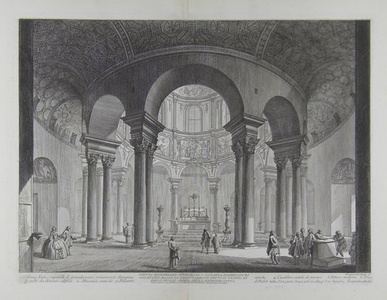| Method | Etching |
| Artist | Giovanni Battista Piranesi |
| Published | Piranesi Architetto fec. Presso l'Autore a Strada Felice vicino alla Trinita de Monti. A paoli due e mezzo. [Rome, 1760-1778] |
| Dimensions | Image 398 x 550 mm, Plate 416 x 558 mm, 526 x 765 mm |
| Notes |
Inscription to left and right of title reads: '1. Colonne, basi, e capitelli di grandezza e ornamenti disuguali, tolti da diversi edifizi. 2. Musaici antichi. 3. Finestre antiche. 4. Candelieri antiche di marmo. 5. Pitture moderne. 6. Urna di Porfido tutta d'un pezzo lunga pal. 11. alta p. 5.10 larga 6.9. Il coperchio alto 3.2.' A view of the interior of the Church of Santa Constanza, in Piranesi's day often known erroneously as the 'Temple of Bacchus, from the Vedute di Roma. The view brilliantly evokes the unusual circular layout of the 4th century church, and the foreground is populated by a number of men and women in Italian aristocratic dress. Unlike the comments on many of Piranesi's other views, the numbered key to this plate is unusually concise, listing the features of the church as including an antique mosaic, an antique window, an antique marble candelabra, and a series of modern frescoes. The Church of Santa Constanza is one of Rome's oldest, having stood in much the same form since the 4th century AD. Traditionally viewed as having been constructed by the emperor Constantine as a mausoleum for his daughter Constantina, more recent scholarship suggests it was likely built instead for Helena, another daughter of Constantine and wife of the Emperor Julian. Ironically, the apostate Julian may actually have been responsible for the building's construction. The Church stands on the side of the Via Nomentana, over part of the earlier Christian catacombs of St Agnes. The Vedute di Roma was Piranesi's most popular and best known series, celebrating the churches, monuments, ruins, bridges, fountains, and public spaces of the city of Rome. The immense popularity of the series meant that they were in constant demand, and Piranesi continued to reissue and add to the series from the 1740s until his death in 1778. The Vedute were particularly popular with British grand tourists, and had a profound effect on the British Neoclassical movement. Demand was such that the series was reprinted numerous times after Piranesi's death, including two Paris editions published by his sons, Francesco and Pietro. Giovanni Battista (also Giambattista) Piranesi (1720 – 1778) was an Italian artist famous for his etchings of Rome and of fictitious and atmospheric "prisons" (the Carceri d'Invenzione). He was a major Italian printmaker, architect and antiquarian. The son of a Venetian master builder, he studied architecture and stage design, through which he became familiar with Illusionism. During the 1740's, when Rome was emerging as the centre of Neoclassicism, Piranesi began his lifelong obsession with the city's architecture. He was taught to etch by Giuseppe Vasi and this became the medium for which he was best known. Hind 37.iii/vi, Wilton-Ely 158, Focillon 811, C705 Condition: Strong impression with wide margins. Central vertical fold. Minor creasing to central fold at margins, not affecting plate or image. Early manuscript '12' in black ink at top right corner of sheet, not affecting image or plate. |
| Framing | unmounted |
| Price | £1,200.00 |
| Stock ID | 42293 |

